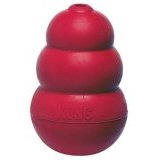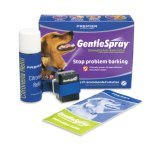Separation Anxiety in Dogs Page 2
Leave home quietly and come home
quietly
As often as you can, step out of the front door while your dog is watching as
well as when he is not watching. At
first, step outside for a few seconds and then come right back in before he has a chance
to get upset. Do this several times a day varying the amount of time you are
outside. Vary what you do as well. Take your coat, keys and briefcase
sometimes. At other times just take a walk around the block.
If you normally leave through the garage
door, substitute that for the front door. The idea is to remove the
association between a specific door and your dog being left alone for a long time.
If you have a specific routine before you leave for the day, try varying the
routine. You can also go into a room, close the
door behind you leaving your dog outside (or vice versa). This accomplishes the same
purpose as actually leaving the house if your dog normally gets upset when you put a door
between you.
Your dog can become a prisoner of habit.
If he is used to feeling stressed and anxious whenever he sees you go to the
hall closet and take out your coat, force of habit can make him continue to do
so. Mix up the routine, leave your coat and briefcase and keys in the car
in the garage and slip out quietly. Soon he will not be able to tell whether you are leaving for 10 seconds or 3 hours.
Try not to make a big show of leaving or
coming home.
A dog with separation anxiety finds the experience of you leaving very stressful
so be the calm one! When you return, greet him calmly and ignore his
crazy antics. Just come and go without any fanfare. For some dogs,
completely ignoring him for 15 minutes before leaving and after coming home
works very well.
Give your dog plenty of exercise,
socialization and fun
A dog that is tired and happy is more likely to sleep and not get into
trouble. If you can arrange it, take him on a long walk right before you
leave.
A long walk or jog consists of 1-2 hours (or more if you can manage it) of
active walking, jogging, or running with your dog, not a leisurely 20 minute
stroll down the street. If your dog is particularly active and you are
not, you may have to consider biking, skating or scootering with him. As a
last resort, you may want to consider a treadmill.
Although a romp at the dog park is an option, many dogs do not
get much exercise at parks and a dog with separation anxiety needs to move at a
constant, fast pace over a long period of time to ease that anxiety and become
tired and satisfied. If you have a retriever, an hour or so of continuous
running and retrieving may do the trick.
If you plan on exercising with your dog before you head off to
work in the morning, you may need to wake up several hours ahead of your normal
schedule. With a large, young dog you will need to add 1-2 hours of
walking or 1 hour of cycling, roller-blading or active retrieving. You
will then want a cool down period before feeding him and leaving him for the
day.
If you find that a significant increase in exercise decreases
the separation anxiety, you can then see if exercise at more convenient times
works as well.
Feed him before you leave
Some dogs become more tense if they are hungry. A stomach-filling meal with complex
carbohydrates like
oatmeal
can make him sleepy and relaxed. The goal is to have a well-exercised,
well-fed dog happily engaged in snoozing before you leave.
Leave the radio on
An empty house can be unnerving to some dogs. They can hear every car, pedestrian,
delivery person and squirrel that is outside the door. A strange sound can set off
whining and barking. A radio can add some white noise to the environment and dampen
his reaction to what is going on outside. You can try a classical music station or
some mild talk radio. Controversial talk radio, with lots of people arguing and loud
commercials can make the situation worse. Try National Public Radio (no commercials,
lots of serious chat) which is usually available on a local FM station in your area.
Give him something to do
A second pet could be the answer. With a second pet in the house, your dog won't
feel as abandoned. If this is not possible, try some engaging activities:
Try giving him a cardboard box to shred
(just make sure he is not the type to eat
the box)
 Give him a treat-filled dog toy such as a
puzzle box or rubber chew made just for dogs. Some people swear by hollow
rubber chew toys stuffed with the daily meal, plugged with cream cheese and then
frozen solid. You will have to try out a few concoctions and toys to see
what works. You will want to have one that will occupy your dog for an
hour or so or at least long enough for him to forget that you have left him
alone! Give him a treat-filled dog toy such as a
puzzle box or rubber chew made just for dogs. Some people swear by hollow
rubber chew toys stuffed with the daily meal, plugged with cream cheese and then
frozen solid. You will have to try out a few concoctions and toys to see
what works. You will want to have one that will occupy your dog for an
hour or so or at least long enough for him to forget that you have left him
alone!
This type of treat works if your dog only receives this when
you leave the house. Making a strong association between a special
treat and being alone can make the being alone less frightening, frustrating
or boring.
Give him several chew toys that you rotate
every few days. These could include rope toys, nylon bones and other safe
toys. 
Dogs are intelligent creatures and
sometimes they get into trouble out of boredom and frustration. Try
teaching your dog basic obedience (sit, heel, stay, etc.) and some party tricks
(play dead, fetch slippers, etc.) It will give him something to think
about when he is alone.
Try a crate
If your dog is seriously destructive to your house, you may have to confine him while you
modify his behavior.
Crates come in
many different styles. The best one for you will depend on your dog.
Crates can cost $50 and more for a medium sized one to over $100 for a large size and are well worth it.
A sturdy crate, bought when your dog is a puppy, will last a lifetime.
Crates are only temporary
solutions and dogs should not remain in them for more than a few hours at a time.
Although it may seem cruel to confine a dog, many dogs feel secure in their crates and the den-like confined space
can help
them doze off.
Make sure you have crate-trained your dog before you leave him alone for any
length of time. The crate should be a place of security and pleasant
experiences and never a punishment or a prison.
When not to use crates
Not all dogs take to crates. Some dogs are claustrophobic and will suffer
even more when confined to a crate. They may do better in a room with a view and
sometimes even better if given the run of the house but with the additional
behavior modification as discussed in this article. If your dog claws at
the crate door, bites the bars and shows excessive distress at being placed in a
crate, the crate is probably not for him.
  Try an anti-bark
citronella collar Try an anti-bark
citronella collar
Some dogs bark incessantly when their anxiety levels are high. If this
is an issue, try a citronella collar that spurts a cloud of citronella into your
dog's face when he barks. The collar consists of a battery-operated box
that is loaded with citronella. The box is attached to a webbing collar
that goes around your dog's neck. The vibrations from your dog's bark will
set the collar off. The collar sends a spurt of citronella which surprises
your dog into silence. Dogs quickly learn the routine.
This is a fairly expensive product but it can provide immediate
relief for some dogs. The box may be too large and heavy for very small dogs and
it may not work at all for very stubborn or overly sensitive dogs. The
collar may increase the anxiety of some dogs. You may have to thin
or trim the neck hair of long-haired dogs or the vibrations from barking may not
register with the box. In addition, with double coated dogs, the
citronella may simply go into your dog's coat. It is both the spicy scent
and the surprising spurt of air that gets your dog's attention. For
some dogs, using the collar without the spray is sufficient.
You may not have to use the collar for an extended period of
time. It should be used in conjunction with behavior modification,
increased socialization, increased exercise and possible medication. There
are also similar collars that provide electric shocks instead of the spurt of
air with citronella. If you are desperate to stop incessant barking and
you have a highly insensitive dog this may be a last resort.
As with all such tools, these collars are effective when they
are on and in working order. They do not train your dog but are a
temporary measure only.
Aromatherapy and Dog Appeasement Pheromone or DAP
Dogs have such highly developed senses of smell that aromatherapy may work
better for them than it does for humans. Consider adding some calming
scents, such as lavender, to his environment. A plug-in air freshener or a
stick scent-diffuser are safe ways to provide long-lasting and continuous scent. aromatherapy may work
better for them than it does for humans. Consider adding some calming
scents, such as lavender, to his environment. A plug-in air freshener or a
stick scent-diffuser are safe ways to provide long-lasting and continuous scent.
 Associate the scent with pleasant experiences such as receiving
favorite treats or having a soothing massage. This may or may not work but
at least your house will be nicely scented. Associate the scent with pleasant experiences such as receiving
favorite treats or having a soothing massage. This may or may not work but
at least your house will be nicely scented.
  A
more targeted approach are products that mimic the scent of a nursing mother.
Since dogs associate nursing with feeling calm and secure, this product hopes to
recreate that feeling. The Dog Appeasement Pheromone or DAP comes in a
variety of forms including a collar, a plug-in diffuser and a spray. It may take some
time but it is said to work very well with some dogs and not at all with other
dogs. A
more targeted approach are products that mimic the scent of a nursing mother.
Since dogs associate nursing with feeling calm and secure, this product hopes to
recreate that feeling. The Dog Appeasement Pheromone or DAP comes in a
variety of forms including a collar, a plug-in diffuser and a spray. It may take some
time but it is said to work very well with some dogs and not at all with other
dogs.
Page 1 2
3
|
